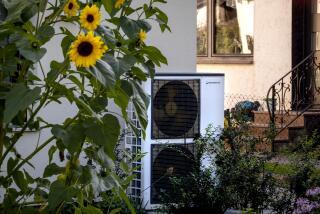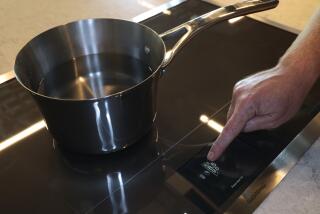UTILITIES : Cold, Hard Facts About Heat Pump Include Its Fine Economic Climate
- Share via
The climate in many newer homes is governed by an electric heat pump instead of a furnace or central air conditioner.
Compared to electric heating, heat pumps are economical: For each kilowatt of electricity consumed, a heat pump typically produces from 1 1/2 to three times as much heat as conventional electric baseboard units.
And because a heat pump can cool as well as heat, the cost of owning two separate units is saved. The pumps pay off best in the Sun Belt, where winters are mild. Most heat pumps cost about the same to buy and run as a central air conditioner.
A heat pump is a mechanical refrigeration system, perhaps best described as a reversible air conditioner. Like a central air conditioner, heat pumps require a system of air ducts throughout the house.
The main components are an indoor unit and an outdoor unit, each containing a hollow metal coil and a compressor to which both coils are attached.
Pressurized refrigerant liquid cooled to a sub-zero temperature flows through the system. In summer, the refrigerant absorbs heat from the air surrounding the indoor coil and carries it to the outdoor coil, where it is released. In winter, reversing the flow of refrigerant draws heat from the outside air and carries it indoors.
As outdoor temperatures cool below freezing, most heat pumps lose efficiency because the air contains less heat to absorb. To compensate, supplementary electric heating elements switch on when the unit does not have enough heating capacity to satisfy the needs of the home.
It is inefficient to lower the night temperature setting on most heat pumps. Extra warming needed in the morning may cause the system to draw on supplementary heating elements.
If you own a heat pump, have it serviced annually by a qualified contractor, preferably the installer. Routinely vacuum the indoor coil if it is accessible; change the filter (also indoors), and wash the outdoor coil by spraying it with a garden hose. Never operate a heat pump without the filter in place; dust coating the coil reduces the heating and cooling efficiency and in extreme cases can cause the compressor to overheat.
Occasionally, you may need to lubricate the fan motor or adjust the blower and drive belt. Check the owner’s manual for your model and call for professional service if you do not understand what to do.
Following are some common heat pump maladies and cures:
* Frost forming on the outdoor coil in winter and on the indoor coil in summer is normal during certain combinations of temperature and humidity. Keep the unit clean and change the filter at least once a month during the height of heating and cooling seasons. Avoid replacing the filter with one that is denser than the original; this can strain the unit and lengthen the defrost cycle. Call for service if the problem persists or if ice forms instead of frost.
* Cool air blowing from ducts during heating also is normal. Actually the air is sufficiently warm to heat the room (usually air from a heat pump is about 10 degrees warmer than room temperature), but as with air from a fan, it feels cool against the skin because it is moving. If heat is inadequate in very cold weather, make sure the supplementary heating element is working. If not, call for service.
* If a heat pump cycles on and off frequently, check the thermostat; it may be broken or incorrectly set. The owner’s manual should contain instructions for setting the thermostat.
More to Read
Inside the business of entertainment
The Wide Shot brings you news, analysis and insights on everything from streaming wars to production — and what it all means for the future.
You may occasionally receive promotional content from the Los Angeles Times.










